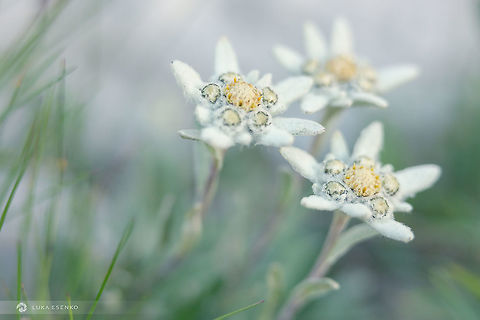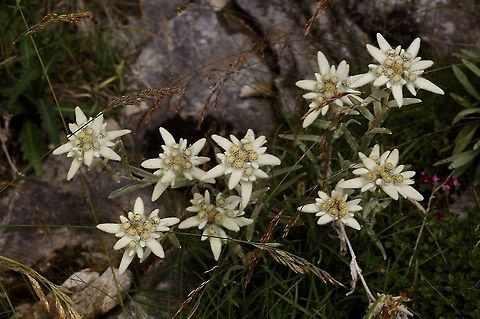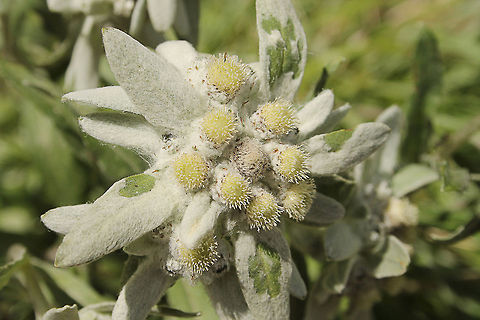
Appearance
Leaves and flowers are covered with white hairs and appear woolly . Flowering stalks of Edelweiss can grow to a size of 3–20 cm . Each bloom consists of five to six small yellow flower heads surrounded by bracts in star formation. The flowers are in bloom between July and September.
Naming
The common name comes from German ''edel'', meaning "noble", and ''weiß'' "white", thus signifying "noble whiteness".The scientific name ''Leontopodium'' is a Latin adaptation of Greek ''leontopódion'' "lion's paw", from ''léōn'' "lion" and ''pódion'' "foot" .
The first scientific name for Leontopodium alpinum which was validly published according to the current binomial nomenclature is ''Gnaphalium alpinum'' in the first edition of Linnaeus's ''Species Plantarum''.

Status
Edelweiss is a protected plant in many countries, including Mongolia, Bulgaria, Croatia, Switzerland , France, Norway, Iran, India , Italy, Serbia, Malaysia , Indonesia , Germany, Spain , Poland and Slovakia , Slovenia , Austria and Romania .Uses
* On the Austrian 2 cents coins, a picture of Edelweiss is used on the two-euro-cent coins.⤷ It is the symbol of the and the Bulgarian Mountain Control and Lifeguard Service , http://pss.bg.
⤷ It is also the symbol of the
⤷ On the Romanian 50 Lei banknote.
⤷ In Austria, ''Edelweiß'' is also a brand of beer named after the flower.
⤷ Edelweiss is the unofficial national flower of Switzerland.
⤷ The Edelweiss is used in the logotypes of several alpine clubs such as the ''Deutscher Alpenverein'' or the Österreichischer Alpenverein . The Edelweiss is also used in the logotype of the Union of International Mountain Leader Associations .
⤷ Edelweiss Air, an international airline based in Switzerland, is named after the flower, which also appears in its logo.
⤷ The song "Edelweiss", which is about the flower, is from Rodgers and Hammerstein's 1959 musical ''The Sound of Music'', which takes place in Salzburg, Austria before World War II.
⤷ "Bring me Edelweiss" is the best-known song of the music group Edelweiss.
⤷ The Edelweiss was established 1907 as the sign of the Austrian-Hungarian alpine troops by Emperor Franz Joseph I. These original 3 Regiments wore their edelweiss on the collar of their uniform. During World War I the Edelweiss was granted to the German alpine troops, for their bravery. Today it is still the insignia of the Austrian, Polish, and German alpine troops.
⤷ Edelweiss was a badge of Edelweiss Pirates —the anti-Nazi youth groups in Third Reich. It was worn on the clothes .
⤷ The Edelweiss flower was the symbol of Wehrmacht and Waffen-SS Gebirgsjäger, or mountain rangers, worn as a metal pin on the left side of the mountain cap, on the band of the service dress cap, and as a patch on the right sleeve. It is still the symbol of the Mountain division in the German army today.
⤷ The World War II Luftwaffe unit, Kampfgeschwader 51 was known as the Edelweiss Wing.
⤷ The rank insignia of Swiss generals use eight-pointed stars representing the flower. A ''Korpskommandant'' for example wears three ''Edelweiss'' stars on his collar.
⤷ Polish professional ice hockey team MMKS Podhale Nowy Targ use an Edelweiss as their emblem.
⤷ The Edelweiss is represented as the favorite flower of Adolf Hitler, in the 1934 recording "Adolf Hitlers Lieblingsblume ist das schlichte Edelweiß", sung by Harry Steier.
⤷ Edelweiss Lodge and Resort is a military resort located in GarmIsch, Germany.
References:
Some text fragments are auto parsed from Wikipedia.